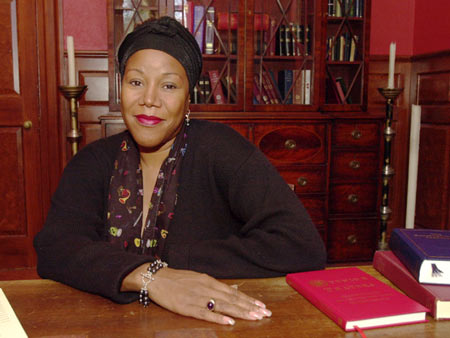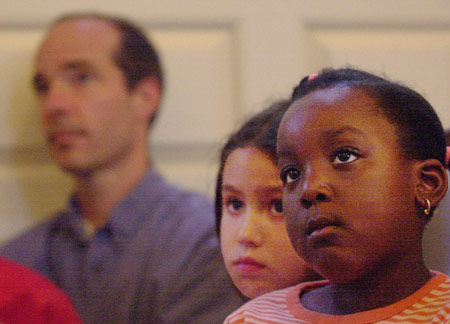Ruby Bridges evokes tears, smiles as she tells her tale

Grownups and children filed quietly into the Memorial Church on April 18, their faces bright with expectation. A group of teenagers with the letters YMCA emblazoned across their sweatshirts looked for a pew where they could sit together as the church quickly filled.
They all came to hear Ruby Bridges tell her story. Bridges was one of the first black children, in 1960, to attend an all-white public elementary school in the South. And she was the only black child to enter the William Frantz school that year, the year that elementary and secondary school integration began in Louisiana and four other Southern states that had been resisting school integration.
A few minutes before the talk, Claudia Highbaugh stood at the front of the church, surveying the growing crowd. “This is really emotional for me,” said the Divinity School chaplain, who wasn’t expecting such a turnout. “Finally, I get to be with one of my icons, a black woman-child whose truth becomes part of our historical record. The children’s stories were buried for so long,” she said, her eyes brimming.

The talk was co-sponsored by the Divinity School, the Memorial Church, the Graduate School of Education, Harvard Children’s Initiative, Adams House, and the Division of General Pediatrics at Children’s Hospital. Highbaugh delivered the opening remarks.
Because Bridges is only in her mid-40s, it may seem strange to think how central her story is to the history of civil rights. She stood quietly on the altar while a brief videotape showed her at 6 years old entering the William Frantz school in New Orleans, clutching her mother’s hand. They’re surrounded by four white men wearing yellow armbands. These were the federal marshals sent to protect Bridges from the jeering mobs of segregationists, who threatened her and held aloft a small coffin with a black doll inside.
“I remember that morning, I saw lots of people standing in the streets,” Bridges said. “They were shouting and throwing things.” She recalled thinking, “‘Today is Mardi Gras, and I am in a parade.’” Members of the audience smiled at this poignant misinterpretation in the mind of a 6-year-old.
Bridges’ story inspired Norman Rockwell’s famous painting, “The Problem We All Live With,” depicting a small black girl in starched white dress marching resolutely, flanked by federal marshals. Rockwell had learned of Bridges’ ordeal through author John Steinbeck, who wrote about it in his book “Travels With Charley.”
It wasn’t just the first day that was difficult and strange for the little girl. Bridges was lonely that year in school, because most whites pulled their children out of the William Frantz to protest integration. For a while, Bridges was the only child in her first-grade class. Luckily, her teacher provided a nurturing and stimulating environment.
When she initially met her instructor, Barbara Henry, Bridges must have felt apprehensive. “I had never seen a white teacher before,” she said, “but Mrs. Henry was the nicest teacher I ever had. She tried very hard to keep my mind off what was going on outside. But I couldn’t forget that there were no other kids.” When she looked out the window at the playground, empty except for the federal marshals, the first-grader thought to herself, “Maybe they’re looking for the kids.”
In her 6-year-old mind, Bridges couldn’t understand why there were no other children in her class. Finally, her beloved teacher upbraided the principal, threatening to report him for supporting the white parents’ boycott. One day soon after that, other children came to school. But no one would play with her. Bridges recalled, “One boy said to me, ‘My mom said not to play with you because you’re a nigger.’ Then I finally understood. I finally knew it was about me and the color of my skin. But I was never angry with that boy. In my mind, he was just explaining to me why he couldn’t play with me.”
She underlined her classmate’s words, “My mother said,” and urged those gathered to remember that racism is taught. “Each and every one of us,” she said, “is born with a clean heart. Our babies know nothing about hate or racism. But soon they begin to learn – and only from us. We keep racism alive. We pass it on to our children. I think that is very sad.
“You cannot look at a person and tell whether they are good or bad,” Bridges continued. “It’s time to get past our racial differences. We owe it to our children to help them keep their clean start.”
As one, the crowd rose to its feet. Black and white, young and old clapped for the woman who had brought them a message they all seemed hungry to hear.




